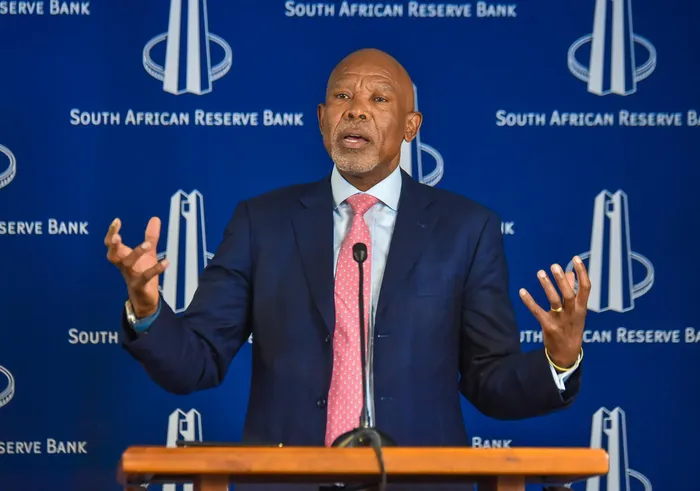MPC sticks to its guns and discounts 3% inflation target

Lesetja Kganyago, governor of the South African Reserve Bank. The MPC decided to keep the policy rate unchanged, .
Image: SARB/Facebook
Despite the lowering of the US Federal bank rate by 0.25% last Wednesday and the sudden decrease in South Africa’s inflation rate in August to 3.3%, from 3.6% in July, the Monetary Policy Committee (MPC) still decided to keep the repo rate unchanged.
The main reasons for the sudden decrease in the August inflation rate were that annual fuel prices decreased by -4.7% and decreased by -0.8% for the month alone. The contribution of the total transport sector to the annual inflation rate also came down by -0.2%. Food prices increased at a lower rate of 5.2% against the annual increase of 7.2% in July. Month on month there was a -01% decrease in food and non-acholic prices and it contributed 0.9% to the total inflation rate of 3.3% against the 1.0% the previous month.
In its press release on Thursday, the MPC declared that: “Our inflation projections also have upward adjustments to food and services prices, partly offset by a stronger exchange rate assumption. Overall, we expect headline inflation to average 3.4% this year, and 3.6% next year, before reverting to 3% during 2027.”
The MPC, therefore, believes that last month’s lower-than-expected food price inflation may only be a once off. Also given the higher electricity price inflation, of 8% rather than 6%, given the recent pricing correction by Nersa, will keep pressure on the headline inflation to remain higher than the MPC’s “unofficial” new target of 3.0%. Therefore, the decision not to lower the repo rate.
One wonders if there is not a broader target of the exchange rate to keep the inflation differential with the US, UK, and the Euro-area higher to initiate a stronger Rand.
Equity markets remain bullish.
Stock prices on the JSE recorded for the fifth week in a row an upward movement. This is despite some negative sentiment on Friday in reaction to the interest rate decision by the MPC.
The All Share index recorded a record level of 106 111 points on Friday, gaining 1 226 points(1.2%) over the week.
Although financial shares were expected after the repo rate announcement contracted on Friday, FIN15 ended the week stronger with an increase of 0.7% on the previous Friday.
Precious metals prices remain bullish. The gold price reached a new record level of $3 690 on Tuesday and closed Friday still $38 higher than the previous week. Platinum closed the week flat on $1 413 per ounce but the palladium price lost 2.3%.
The US Federal Reserve lowering rates further remains a strong possibility. Most of the 107 economist taking part in a Reuters Poll expected that the US Fed would cut its bank rate last Wednesday by 25 basis points and with another 25 basis points during the next quarter, and another one during the first six months next year. The weaker labour market that is expecting not to create any more new jobs seems to overshadow inflation risks. Although stocks on Wall Street evaluated the dovish outlook by the Fed on interest rates and surged up last week, JP Morgan said that the Fed decision on Wednesday to lower rates could end up sending stocks into a nosedive as investors "sell the news”, meaning that investors may pull back to evaluate the poor macro-economic data.
S&P500 ended the week 1.22% higher on a new record level, gaining 16.8% over the last year. The Dow Jomes Industrial Index increased by 1.05%, up by 10.1% over the last year and the tech loaded Nasdaq advanced by 2.21% and 26% over the past 12 months.
Prospects for this coming week
South Africa awaits the release of its consumer confidence index for quarter three and producer price inflation (PPI) for August this coming Thursday. It is expected that the annual increase in PPI in August was lower at 1.3% against the 1.5% annual increase in July.
On global markets the speech by the Federal Reserve on Tuesday will shed some more light on the Fed’s decision to lower its bank rate last week and if one may expect a series of cuts in months to come. Thursday awaits the release of the US’s final estimate of its GDP growth rate during Q2. The US will also release its durable goods orders for August on Thursday and on Friday the important personal income and spending data during August.
In Europe and the UK, various Purchasing Managers Indices (PMI’s) for September will be released this week.

Chris Harmse is the consulting economist of Sequoia Capital Management and a senior lecturer at Stadio Higher Education.
Image: Supplied
Chris Harmse is the consulting economist of Sequoia Capital Management and a senior lecturer at Stadio Higher Education.
*** The views expressed here do not necessarily represent those of Independent Media or IOL
BUSINESS REPORT